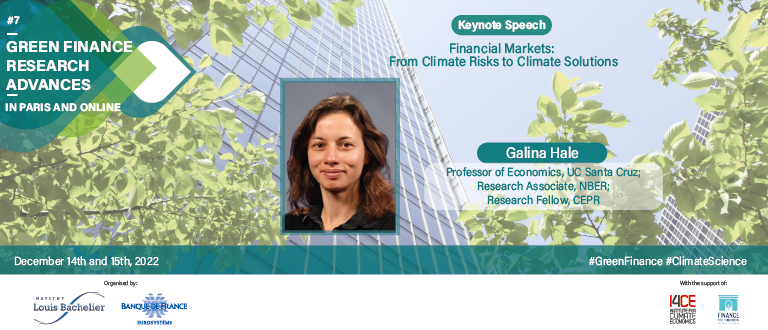Galina Hale, Professor of Economics at UC Santa Cruz, Research Associate at NBER and Research Fellow at CEPR, will deliver a keynote on “Financial Markets: From Climate Risks to Climate Solutions” on December 14th, 9:25-10:10 CET at the 7th edition of the “Green Finance Research Advances” conference, co-organized by Banque de France and the Institut Louis Bachelier.
The extent and materiality of climate-related financial risks crucially depend on how much these risks are already priced in. This keynote speech will address a brief overview of such risks and summarize from the existing literature on how much the climate risks are priced in across different asset classes. It will also discuss challenges and opportunities for engaging financial markets in financing climate solutions.
Galina Hale’s research interests lie in three main areas: understanding patterns of international capital flows, stability of the financial system, and the nexus between ESG sustainability goals and financial system. Galina has published her work in highly rated economics and finance journals.
On the sidelines of the conference, Galina kindly accepted to answer a three-question interview, which we invite you to read below.
***
Climate change refers to shifts and transformations that happen over long-time horizons, extending beyond the traditional horizons of most financial actors. While an understanding of long-term phenomena governing the joint evolution of climate and the economy is key, as well as accounting for financial institutions’ transition plans to the net-zero world of the future, there are also short and medium-term dynamics associated with the transition. What are the key short-term risks associated with climate change and the transition?
GH: I see three main sources of transition risks: government policies for climate mitigation (e.g. CO2 tax), technological innovations that could lead to stranded technologies, and investor and consumer preferences shift away from emitting products to neutral and to active climate solutions. Financial markets’ reaction to such changes could be rapid, leading potentially to larger asset repricing.
What is in your views the role of central banks and supervisors in addressing these shorter-term climate-related risks?
GH: First, incentives are needed for financial institutions to recognize these risks properly, including any roll-over risks that arise at longer maturities. Second, central banks and supervisors can provide expert help with best practices and data collection. As always, convening and raising awareness globally is important.
What are key academic research questions related to these short and medium-term transition risks?
GH: These risks are very hard to assess empirically, due to data limitations and non-linear nature of the risks. Some of the questions that are already researchable would be related to the efficacy of existing central banks’ and supervisors’ incentives for greening portfolios on actual real investment across climate-exposed, neutral, and green industries. Separately from these risks, innovations in financial instruments are needed to make investment in climate solutions attractive to private financial sector.
—
Don’t miss the keynote intervention of Galina Hale at Green Finance Research Advances! The 7th edition of GFRA will take place on December 14-15, 2022, in Paris and online.
The objective of the conference is to bring together academics, finance practitioners and regulators, to discuss together research issues related to the integration of climate risks (more generally environmental issues) into macro-economic modelling/forecasting and into the risk assessment of the financial sector.

